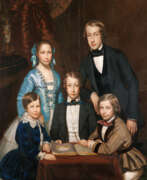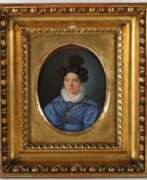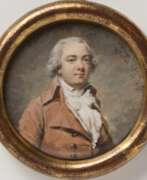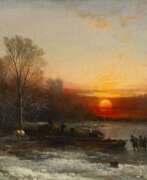Miniaturists 19th century


Nikolai Ivanovich Argunov (Russian: Николай Иванович Аргунов) was a Russian painter of the late 18th - the first third of the 19th centuries. He is known as a painter, graphic artist, miniaturist, representative of Russian classicism.
Nikolai Argunov is considered one of the greatest portrait painters of his time. His works are notable for their diversity, psychologism, objective approach to nature, devoid of classicist idealization and romantic heroization of the models.
The artist was a serf, was granted his freedom after the death of his master and became an academician of the Imperial Academy of Arts in St. Petersburg. He was a member of a dynasty of artists, the beginning of which began with his father Ivan Argunov.


Jean Henri Benner was a French miniature painter and portraitist.
Benner was a pupil of the French painter Jean-Baptiste Isabey (French: Jean-Baptiste Isabey, 1767-1855). In 1815-16 he worked in Warsaw, and from 1816 to 1825 - in St. Petersburg, where he painted portraits of representatives of the Russian and Polish aristocracy.
In Russia Henri Benner also created a series of 24 portraits of the Russian tsars of the Romanov dynasty, members of their families and court dignitaries - the so-called "Romanov Suite". This series is unique: it is executed in several sets. Now three sets of the series are kept in the State Hermitage.
In parallel, Benner created other albums of miniature portraits, which enjoyed great success at the time. And even before Russia, in 1812, he executed a series of miniatures depicting representatives of the Habsburg dynasty.


Isaac Robert Cruikshank or Robert Cruikshank was a British caricature artist, illustrator and miniature portraitist.
Robert is the older brother of George Cruikshank (1792-1878) and son of Isaac Cruikshank (1764-1811), who were also caricaturists and illustrators. Robert illustrated novels with his brother, including Cervantes's Don Quixote, and the London Characters series in 1827.


Woldemar Hau (Russian: Владимир Иванович Гау) was a Baltic German portrait painter, renowned for his contributions to the Biedermeier style, a period marked by a sense of realism and simplicity in art. Born in 1816 in Tallinn, then part of the Russian Empire, he was trained under the guidance of his father, Johannes Hau, and the distinguished artist Karl von Kügelgen. Hau's remarkable talent became evident early on when, at just sixteen, he was recommended to paint for the Russian Imperial Court, leading to his appointment as a Court Painter.
During his illustrious career, Hau captured the visages of the Russian nobility, including Tsar Nicholas I and Tsarina Alexandra Fyodorovna, alongside other key figures of his time. His works, often characterized by their intricate detail and vibrant realism, include over 200 miniature portraits of the Izmaylovsky Regiment veterans. His most celebrated works are preserved in prestigious collections and reflect his mastery in both watercolours and miniatures on ivory.
For those interested in exploring the legacy of Woldemar Hau, his paintings are a fascinating window into the cultural and historical nuances of 19th-century aristocratic Russia. To stay updated on exhibitions and auctions featuring Hau's work, I encourage you to sign up for updates. This subscription will keep you informed about new sales and auction events specifically related to Woldemar Hau.


Franz Michael Katz was a nineteenth-century German painter. He is known as a graphic artist, watercolorist, portraitist, miniaturist, collector and teacher.
Katz founded the Higher School of Drawing and Painting in Cologne, which quickly gained a reputation as a prestigious institution for the city's wealthy residents. He was also a member of the "Olympic Society," founded in 1809, which brought together lovers of art and literature. As a collector, the artist amassed a significant collection of paintings, copperplate engravings, and plaster casts of ancient statues.


Johann Baptist Lampi the Younger was an Austrian portrait painter, renowned for his detailed and expressive portraiture. Born on March 4, 1775, in Trento, Lampi was educated at the Academy of Fine Arts Vienna under the guidance of Hubert Maurer and Heinrich Friedrich Füger. His artistic journey began under the tutelage of his father, Johann Baptist von Lampi the Elder, a prominent painter himself.
Lampi the Younger's career took a significant turn when he, along with his family, moved to St. Petersburg in 1797, following an invitation from Catherine the Great. This move marked a pivotal period in his life as he produced many portraits of Russian nobility and other significant figures of his time. His notable works during this period earned him a position as a member of the Academy in St. Petersburg and later in Vienna.
Among his well-known works, which can be viewed in major galleries such as the Belvedere Gallery and the Vienna Museum, are portraits of Antonio Canova, Francis I, and Ivan Akimov. His artistic legacy is further highlighted by his influence and contributions to the European art scene of the 19th century.
For enthusiasts and collectors interested in the works of Johann Baptist Lampi the Younger, signing up for updates can provide exclusive access to news about upcoming sales and auction events featuring his works. Ensure you stay informed about opportunities to acquire pieces by this distinguished artist.


Theodore Lane was a British miniature painter, caricaturist and engraver.
Lane became known as a painter of watercolor portraits and miniatures, but his real talent was in satire. He produced a humorous series of thirty-six drawings entitled The Life of an Actor, which was published in 1825, often working on sports material, especially in collaboration with Piers Egan.
As a political pamphleteer, Theodore Lane drew a series of satirical depictions of Queen Caroline and George IV in caricature and grotesque form in 1820.


Carl Johann Lemoch (Russian: Кирилл Викентьевич Лемох) was a Russian painter of the last third of the 19th and early 20th centuries of German origin. He is known as a painter, graphic artist and miniaturist.
Lemoch is considered one of the most notable genre painters in Russia of his time. The leading place in his work was occupied by the peasant theme, which was characterized by a sympathetic image of the hardships of everyday life of peasants. He was the first Russian artist to create miniature portraits with life-size figures.
Lemoch was one of the founders of the St. Petersburg Art Society of Artists and the Association of Traveling Art Exhibitions.


Kenneth Macleay was a Scottish and British portrait and miniature painter and one of the founders of the Royal Scottish Academy.
Kenneth Macleay made his reputation painting portraits in watercolor in sizes ranging from ivory miniatures to full-length images. After painting portraits of Queen Victoria's three youngest sons in the early 1860s, Kenneth Macleay was commissioned to create several more portraits of the Queen's favorite cronies, as well as miniature and watercolor portraits.
This was followed by a larger commission, which became the most important of the artist's career: a series of portraits of the most important Highland clansmen for publication. The first group of portraits were executed in the second half of the 1860s and exhibited by John Mitchell in Old Bond Street in 1869. They were then reproduced in chromolithography by the leading London lithographer Vincent Brooks (1814-1885) as illustrations for the two-volume The Highlanders of Scotland.


Ramón Torres Méndez is a Colombian painter and graphic artist.
A self-taught artist, Méndez achieved great success as a master of miniature portraiture and a representative of the Costumbristo movement. His genre paintings present pictures of Colombian life, which document with documentary accuracy the characteristic types of ordinary people of the mid-19th century, their costumes, occupations and recreation. Méndez's series of drawings, "Customs of New Granada," was lithographed in Bogotá in 1851.


Alessandro Molinari was a German-born portrait painter of Italian ancestry, celebrated for his depictions of the Russian and Polish nobility. Born on January 5, 1772, in Berlin, and passing away on January 20, 1831, in Dresden, Molinari's artistic journey spanned various European locales. His prowess in portrait painting gained prominence during his stays in cities such as Rome, Vienna, and Saint Petersburg.
Molinari's technique and ability to capture the essence of aristocracy allowed him to become a favorite among the nobles during his time in Russia around 1806. His works often reflected a deep understanding of his subjects, infused with cultural insights that appealed to his high-society clientele. Notable pieces by Molinari include a miniature self-portrait circa 1820, showcasing his meticulous skill in this demanding medium. His legacy persists through his contributions to portrait painting, with his works displayed in prestigious institutions such as the Hermitage Museum and the Tretyakov Gallery.
For enthusiasts and collectors of classical portrait art, especially those focusing on European nobility, Alessandro Molinari's works offer a glimpse into the aristocratic life of the 18th and 19th centuries. To stay updated on exhibitions and auctions featuring Molinari's work, consider signing up for our newsletter. This subscription will keep you informed about new findings and sales directly related to Molinari, ensuring you never miss an opportunity to appreciate or acquire his timeless art.


Jean-Laurent Mosnier was a French painter and miniaturist, renowned for his detailed and polished portraitures during the Ancien Régime. Born in Paris in 1743, Mosnier quickly ascended to become a court painter, notably serving Marie Antoinette. His mastery in miniature painting earned him significant acclaim, leading to a prosperous career across various European cities, including London, Hamburg, and St. Petersburg, after fleeing France due to the Revolution.
Mosnier's works are recognized for their exquisite attention to texture and fabric, skills likely honed during his early training at the Académie de Saint-Luc. He became a member of the Académie Royale in 1788, where his works, such as portraits of prominent academicians, solidified his reputation. His career spanned various shifts in his geographical and political contexts, adapting his artistic style to suit the tastes of his diverse clientele, including various European aristocrats and members of the Russian imperial family.
Several of Mosnier's significant works are housed in prestigious museums, including the Louvre and The Metropolitan Museum of Art, ensuring his legacy within the annals of European art history. For art collectors and enthusiasts interested in the rich history and exquisite craftsmanship of Jean-Laurent Mosnier's works, keeping updated on exhibitions and sales is invaluable. Sign up for updates on new product sales and auction events related to Jean-Laurent Mosnier to enhance your collection and appreciation of this distinguished artist.


Nathaniel Plimer was a British miniature painter and portraitist.
Like his brother Andrew Plimer, he studied first with his watchmaker father, but both ran away and traveled for over two years in Wales and the west of England with a troupe of gypsies before settling in London. Together they studied miniature painting under Richard Cosway (1742-1821). Nathaniel Plimer exhibited at the Royal Academy from 1787 to 1815, and his portraits were much appreciated by his contemporaries.


Andrew Plimer was a British miniature painter and portraitist.
His older brother was Nathaniel Plimer, also a miniature painter. They were first trained by their watchmaker father, and later studied the art of miniature painting together in London with the famous portrait painter Richard Cosway (1742-1821). Andrew Plimer specialized in portrait miniature painting and excelled in it, his work being exhibited at the Royal Academy.


Ivan Pavlovich Pokhitonov (Russian: Иван Павлович Похитонов) was a Russian artist of the late 19th and early 20th centuries. He is known as a painter and graphic artist, a master of landscape, who lived and worked in Europe for much of his career.
Ivan Pokhitonov created mainly miniature landscapes, made with a small brush on planks of red or lemon wood, treated and primed with a special technology. He worked mostly in plein air. The most common motif of his miniature paintings during the years of emigration were city and seascapes of France. In his works, always built on a combination of the finest shades of color, the artist organically combined the techniques of Barbizon, of which he was a fan, and the traditions of the Russian landscape school. He also turned to the genre of still life and portraiture.


Aloys-Gustav Rockstuhl (Russian: Алоизий Петрович Рокштуль) was a mid-nineteenth-century Russian artist of Baltic-German origin. He is known as a hereditary miniaturist painter, portrait painter, draftsman, and lithographer.
Aloys-Gustav Rockstuhl had the title of court painter. Almost all of his work consisted of creating miniatures for the Imperial couple - Russian and foreign. The artist painted many portraits of Russian emperors and members of the imperial family.


Mikhail Ivanovich Terebenyov (Russian: Михаил Иванович Теребенёв) was a 19th-century Russian artist. He is known as a painter and watercolorist, the author of genre and historical paintings, as well as portraits, including miniatures.
Mikhail Terebenyov created portraits of famous figures of Russian culture and science, as well as of the heroes of the Patriotic War of 1812. His brushwork also includes oil paintings and watercolors on genre and historical themes, including those reflecting the events of bygone eras and contemporary to the artist.


Thomas Uwins was a British painter and illustrator, and a Royal Academician.
Uwins was a versatile artist, painting portraits, genre scenes, landscapes in watercolor and oil, and book illustrations. Uwins taught, was a member of the Society of Old Watercolorists, and held a number of high-ranking artistic positions, including librarian of the Royal Academy, inspector of Queen Victoria's paintings, and curator of the National Gallery.


Johann Baptist von Lampi was an Austrian-Italian portrait painter renowned for his influential style and significant contributions to the art world. Born in 1751 in Romeno, Tyrol, Lampi’s career took a pivotal turn when he moved to St. Petersburg in 1791. There, he received a hereditary knighthood from the Empress and became a sought-after portraitist, painting notable figures including Empress Catherine II and Maria Feodorovna.
Lampi’s work is characterized by its vivid realism and meticulous attention to detail, qualities that made him a favorite in the Russian court and later in Vienna, where he returned in 1797. His portraits, often rich in texture and color, capture the essence of his subjects with striking clarity. Notable works include portraits of King Stanisław II August and Countess Zavadskaya, displayed in major museums like the National Museum in Warsaw and the Łazienki Palace.
For those interested in exploring Lampi’s legacy further or acquiring pieces associated with him, staying informed about upcoming sales and exhibitions is essential. Sign up for updates to ensure you don't miss out on important auction events related to Johann Baptist von Lampi’s works.























